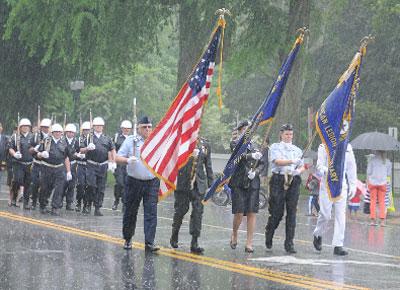Cheers for Vets Despite Downpour
Cheers for Vets Despite Downpour

With a cloud-filled sky giving way to rain, veterans, boy and girl scouts, and members of several fire departments and ambulance companies marched on East Hampton Main Street Monday to mark Memorial Day, 2011.
Despite the downpour, which began in earnest just as the first flag-carrying marchers reached the business district, a sizable turnout of people, young and old, remained to watch the parade go by. Those without umbrellas crowded under store awnings and the eaves of buildings and cheered as the veterans went by. One woman backed her infant in a stroller into a clothing shop's open front door to get out of the rain and secure a view over parked cars.
East Hampton Town Clerk Fred Overton, his notes almost unreadable because of the rain, presided over a ceremony that followed at the Memorial Green near Hook Mill. Among those in attendance were East Hampton Town Supervisor Bill Wilkinson and East Hampton Village Mayor Paul F. Rickenbach Jr.
After the parade, about 200 people gathered in a semi-circle and listened to remarks from Mr. Overton, who is also the commander of East Hampton's American Legion Post No. 419, in Amagansett, and Tom Byrne, the commander of the Everit Albert Herter Veterans of Foreign Wars Post in Wainscott.
Mr. Byrne cited the fighting spirit of the United States military. "The heart of America is freedom," he said.
"We remember our fallen," he said. "Once a year is not enough. Widows, orphans, mothers and fathers, they remember every day."
Bill Fleming, a Wainscott resident who was drafted into the Army in 1970, was the keynote speaker. He said that occasion was a "day of humility and a day of renewal for all of us."
"Small towns like this town supply those who fight and suffer the losses," he said.
"We fight for the ideals that started this nation. . . . Today we renew our commitment to those who served," he concluded.
The names of East Hampton students who won awards from the American Legion and V.F.W. were read at the end of the ceremony.

